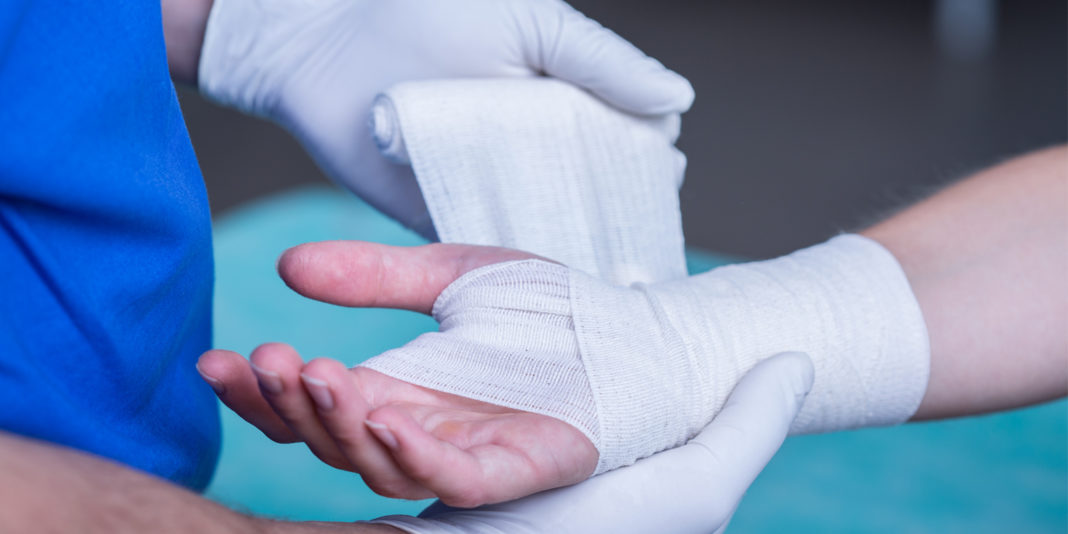Scarring is a natural part of healing. But how large and long-lasting that scar is depends on the wound healing quickly and well. Scabs, itches, infections and other issues that can delay healing can increase the risk of permanent scarring.
For Christchurch clinical nurse specialist Sharon Cassidy, reducing scarring is all about starting with good wound care. Her wound care career began with burns and plastic surgery nursing and expanded to caring for all children’s wounds and in particular caring for the fragile skin of ‘butterfly’ children with the rare skin-blistering condition Epidermolysis bullosa.
For this specialist nurse in burn care for all ages and wound care for children and young people, a key foundation for good wound care and scar-reduced healing is keeping wounds clean, moist and covered to aid pain-free healing.
Educating patients that scabs are not needed
Nurses have long known that scabs hinder rather than help healing.
Cassidy says the rule of thumb is that a wound taking longer than three weeks to heal will scar. Moist wound healing without scabbing can help the wound heal smoothly within the optimal time.
Modern moist wound healing practice began with George Winter’s research in the early 1960s with pigs, which showed, contrary to common belief, that letting wounds dry out and scab actually delayed healing, while wounds kept moist and covered healed much faster.
Moist wound care helps the smooth transition through the four wound healing phases:
- Haemostasis, when the wound clots (immediate).
- Inflammation wound repair stage(0–3 days).
- Proliferation, when the new tissue is rebuilt through granulation and epithelialisation (3–24 days).
- Maturation (up to two years).
If the wound is allowed to dehydrate, the cocktail of blood cells, antibodies and exudate that collects at the wound site during the inflammatory repair and the proliferation phase dries and forms a scab.
This scab crust on the wound was once the best natural protection the body could provide, but, like the poultices of yesteryear, modern wound science has proven that keeping the wound moist is much better.
Many Joe and Jane Public still believe that a scab is an essential step of healing.
“The myth is still out there that you put the wound out in the sun – or let the air get to it – so it dries, scabs and it is healed,” says Cassidy.
Nurses need to educate their patients that a dehydrated wound and scab formation actually delays healing and increases the risk of scarring, because a scab or crust on a wound interferes with the proliferation healing phase.
Proliferation starts with the granulation stage where the extracellular matrix (including collagen and elastin) starts to rebuild tissue in the wound bed, and is followed by epithelialisation, where epithelial cells grow across the wound surface to form the new top skin layer.
For this to happen efficiently, a moist wound bed is needed to promote the growth of the matrix and new skin cells and help their movement across the wound surface. This also promotes the formation of even skin and reduces scarring. But if there is a crust or scab on the wound, this creates a barrier to smooth healing.
“It is like those cells have got to dig under hills to find the moisture they need to form the new wound surface,” says Cassidy.
When the cells burrow deeper to find moist tissue, this can result in a deeper scar. Epithelialisation occurs about three times faster in a warm, moist environment (note: a crust on a wound sometimes also includes, or is made up of, eschar, which is dead tissue and is usually dark or black in appearance).
The aim of good wound care practice is to prevent a wound ‘crusting’, but if a patient turns up with a scab (or eschar) already formed, it is usually best for it to be removed through a gentle debridement technique, such as a hydrating gel, that softens and dissolves the crust so it can be removed without causing trauma to the wound.
If the scab cannot be easily removed, Cassidy recommends applying something like olive oil to penetrate through the crust and ensure the wound bed underneath is kept moist.
Getting the basics right
Reducing scarring also begins with getting other fundamentals of wound care management right, says Cassidy.
This begins with the first essential of cleansing the wound thoroughly to reduce the risk of infection. Infection control also includes good hand hygiene by the nurse and good education on hand hygiene and simple infection control tips for the patient at home.
The nurse will then assess the wound’s tissue viability, wound edges and wound surround, with the aim of creating as clean and flat a wound bed as possible to aid even healing across the wound surface. If there is a blister over a joint, this should be drained to allow movement.
The selection of dressings to keep the wound protected and moist – but not too moist – is the next important step. Depending on the nature of the wound and the amount of exudate, the general rule of thumb is that, after the early inflammation stage, ‘less is best’ when it comes to dressing changes to reduce the risk of damaging the healing wound surface.
Cassidy says offering showerproof dressings to patients – particularly the elderly and the young – is also a good investment so they don’t have to worry about wrapping their wound in plastic to try and prevent it getting wet. A wet dressing allows bacteria to travel into the wound bed, increasing the risk of infection and delaying healing.
When dressing a wound, nurses should also be careful not to damage the patient’s skin, and should take particular care around joints and the webbing between fingers and toes so that movement is not restricted..
Good nutrition is essential because, as Cassidy says, “wounds heal from the inside out” and a diet with high protein food, vitamin C and zinc will promote faster healing. Smoking, diabetes and other conditions affecting blood flow to the wound can delay healing, so it is good to talk to patients about the impacts these can have.
There are many external factors affecting whether a wound causes a permanent scar. These include the depth and size of the wound, the location (joints such as knees and elbows are prone to scarring), the cause of the injury or wound, and the age and health of the person. They also include the person’s ethnicity, as darker skins, which have higher melanin levels, are more at risk of keloid scarring. In addition, the melanin levels in the new skin may differ from the high levels in the surrounding skin, resulting in more variations in skin colour and tone.
“The myth is still out there that you put the wound out in the sun – or let the air get to it – so it dries, scabs and it is healed.”
Healing continues once the wound heals over
Many wound scars will fade and disappear soon after the proliferation phase.
The healed skin might have reddened, but Cassidy points out this doesn’t mean it is scarred, though the redness can take time to dissipate.
Some scars will take longer to become less noticeable and, of course, it is difficult to prevent some scars being lifelong, such as like surgery scars, major burns and wounds over joints.
Maturation (or the scar healing/remodelling phase) takes six months to a year and can continue for up to two years, so skin treatment should continue.
Cassidy says this includes advising patients to avoid exposing the fresh scar to the sun by wearing sunscreen or covering up the wound. The sun can stimulate pigmentation changes in the healing tissue and make the scar darker.
Keeping the moisture levels of the skin high also remains important and Cassidy recommends moisturising the healed wound area daily with a non-perfumed moisturiser. She says case studies and trials have indicated that products containing keratin protein can aid healing and strengthen the skin.
Gentle massage of the healed wound for about 10 minutes once or twice a day can also help to break up and prevent scar tissue during the maturation phase.
Once the scar is mature, the wound area is thought to be about 20 per cent weaker than it was prior to the injury.
If scarring is a major issue, a patient can be referred to a scar management team at their local DHB or a private specialist. An option may include covering the scar with silicon – in the form of sheets, gels or sprays – for a period of months to help healing.
Made-to-measure pressure garments may also reduce the likelihood of a wound scarring. People can explore options such as dermabrasion, laser resurfacing or plastic surgery.
The nurse’s role in reducing scarring starts right at the beginning by providing a good wound care plan and patient support so that the healing cascade flows smoothly without infection, dehydration or fresh damage delaying the wound healing process.
While scarring may be a natural part of healing, it is something that both nurses and patients alike want to see as little as possible.





















